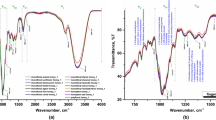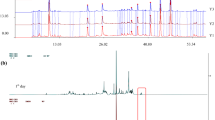Abstract
The potential of right-angle fluorescence spectroscopy and selected chemical parameters for discrimination of botanical origin of Croatian honey types (n = 55) previously classified by physicochemical and melissopalynological analyses was evaluated. Systematic step-by-step fluorescence analysis included the measurement of complete excitation-emission matrix (EEM) in the range of excitation wavelengths from 260 to 400 nm, and emission wavelengths from 300 to 600 nm, followed by fluorescence intensity measurement at detected peaks of different excitation/emission wavelengths, and emission spectra recordings at selected specific excitation wavelengths of honey solutions in 50 mmol L−1 phosphate buffer pH 7.0 and methanol. A total of five different sets of emission spectral data for buffer and two for methanolic honey solutions were considered for chemometric analysis of original and normalized emission spectra including principal component analysis and linear discriminant analysis. Additionally, chemical analysis of buffer and methanolic honey solutions included determination of protein, total polyphenol and reactive amino group content. Results showed that right-angle fluorescence spectroscopy of honey solutions has great potential for honey botanical origin discrimination, either by visual comparison of excitation-emission spectra landscapes, or even better, by normalized emission fluorescence spectra recordings at 260 and 280 nm of excitation. Moreover, increased honey discrimination was achieved in conjunction with chemometrics of fluorescence spectras. In addition, two rapid markers/indicators of honey authentication were found. Chestnut honey could be clearly discriminated from the other honey types by simple measurement of fluorescence intensity at 390/470 nm, while sage honeys by measurement of reactive amino group content.





Similar content being viewed by others
Change history
17 November 2017
The original version of this article unfortunately contained an incorrect version of author’s names and surnames (underlined). The correct names and surnames are: “Ivica Strelec”, “Lidija Brodar”, “Ivana Flanjak”, “Frane Čačić Kenjerić”, “Tihomir Kovač”, “Daniela Čačić Kenjerić”, “Ljiljana Primorac”.
References
Airado-Rodŕiguez D, Durán-Merás I, Galeano-Díaz T, Wold JP (2011) Front-face fluorescence spectroscopy: a new tool for control in the wine industry. J Food Compost Anal 24:257–264. https://doi.org/10.1016/j.jfca.2010.10.005
Anklam E (1998) A review of the analytical methods to determine the geographical and botanical origin of honey. Food Chem 63:549–562. https://doi.org/10.1016/S0308-8146(98)00057-0
Bertoncelj J, Polak T, Kropf U, Korošec M, Golob T (2011) LC-DAD-ESI/MS analysis of flavonoids and abscisic acid with chemometric approach for the classification of Slovenian honey. Food Chem 127:296–302. https://doi.org/10.1016/j.foodchem.2011.01.003
Bogdanov S, Gallmann P (2008) Authenticity of honey and other bee products state of art. ALP Science 520:1–12
Bogdanov S (2009) Harmonised methods of the International Honey Commission. http://www.bee-hexagon.net/. Accessed August 14, 2017
Codex Alimentarius Commission (2001) Revised codex standard for honey. Alinorm:19–26
Christensen J, Nørgaard L, Bro R, Engelsen SB (2006) Multivariate autofluorescence of intact food systems. Chem Rev 106:1979–1994. https://doi.org/10.1021/cr050019q
Conte LS, Miorini M, Giomo A, Bertacco G, Zironi R (1998) Evaluation of some fixed components for unifloral honey characterization. J Agric Food Chem 46:1844–1849. https://doi.org/10.1021/jf970837m
Cotte JF, Casabianca H, Gitoud B, Albert M, Lheritier J, Grenier-Loustalot MF (2004) Characterization of honey amino acid profiles using high-pressure liquid chromatography to control authenticity. Anal Bioanal Chem 378:1342–1350. https://doi.org/10.1007/s00216-003-2430-z
Council of the European Union (2002) Council directive 2001/110/EC of Dec 20, 2001, relating to honey. Off J Eur Commun L10:47–52
de Rijke E, Joshi HC, Sanderse HR, Ariese F, Brinkman UAT, Gooijer C (2002) Natively fluorescent isoflavones exhibiting anomalous Stokes’ shifts. Anal Chim Acta 468:3–11. https://doi.org/10.1016/S0003-2670(02)00630-X
de Rijke E, Out P, Niessen WMA, Ariese F, Gooijer C, Brinkman UAT (2006) Analytical separation and detection methods for flavonoids. J Chromatogr A 1112:31–63. https://doi.org/10.1016/j.chroma.2006.01.019
Dufour C, Dangles O (2005) Flavonoid-serum albumin complexation: determination of binding constants and binding sites by fluorescence spectroscopy. Biochim Biophys Acta 1721:164–173. https://doi.org/10.1016/j.bbagen.2004.10.013
Flanjak I, Strelec I, Kenjerić D, Primorac L (2016b) Croatian produced unifloral honeys characterised according to the protein and proline content and enzyme activities. J Apic Sci 60:39–48. https://doi.org/10.1515/jas-2016-0005
Flanjak I, Kenjerić D, Bubalo D, Primorac L (2016a) Characterisation of selected Croatian honey types based on the combination of antioxidant capacity, quality parameters, and chemometrics. Eur Food Res Technol 242:467–475. https://doi.org/10.1007/s00217-015-2557-0
Fu ZD, Chen XQ, Jiao FP (2012) Study of the interaction of galangin, kaempferol and quercetin with BSA. Latin Am Appl Res 42:211–216
Garcia H, Filzmoser P (2017) Multivariate statistical analysis using the R package chemometrics. Department of Statistics and Probability Theory Vienna University of Technology, Austria. https://cran.r-project.org/web/packages/chemometrics/vignettes/chemometrics-vignette.pdf. Accessed 03. February 2017
Guilbault GG (1990) Practical fluorescence. Marcel Dekker, Inc, New York
Guzeit HO, Henker Y, Kind B, Franz A (2004) Specific interactions of quercetin and other flavonoids with target proteins are revealed by elicited fluorescence. Biochem Bioph Res Co 318:490–495. https://doi.org/10.1016/j.bbrc.2004.04.078
Hermosín I, Chicón RM, Cabezudo MD (2003) Free amino acid composition and botanical origin of honey. Food Chem 83:263–268. https://doi.org/10.1016/S0308-8146(03)00089-X
Jakobek L (2015) Interactions of polyphenols with carbohydrates, lipids and proteins. Food Chem 175:556–567. https://doi.org/10.1016/j.foodchem.2014.12.013
Karagabias IK, Badeka AV, Kontakos S, Karabournioti S, Kontominas MG (2014) Botanical discrimination of Greek unifloral honeys with physico-chemical and chemometric analyses. Food Chem 165:181–190. https://doi.org/10.1016/j.foodchem.2014.05.033
Karoui R, Dufuor E, Bosset JL, De Baerdmaeker J (2007) The use of front face fluorescence spectroscopy to classify the botanical origin of honey samples produced in Switzerland. Food Chem 101:314–323. https://doi.org/10.1016/j.foodchem.2006.01.039
Kenjerić D, Mandić ML, Primorac L, Bubalo D, Perl A (2007) Flavonoid profile of Robinia honeys produced in Croatia. Food Chem 102:683–690. https://doi.org/10.1016/j.foodchem.2006.05.055
Kenjerić D, Mandić ML, Lj P, Čačić F (2008) Flavonoid pattern of sage (Salvia officinalis L.) unifloral honey. Food Chem 110:187–192. https://doi.org/10.1016/j.foodchem.2008.01.031
Kivrak I (2015) Free amino acid profiles of 17 Turkish unifloral honeys. J Liq Chromatogr Relat Technol 38:855–862. https://doi.org/10.1080/10826076.2014.976712
Kivrak Ş (2016) Determination of B-group vitamins in Turkish honey using ultra-performance liquid chromatography with electrospray ionization coupled to tandem mass spectrometry. J Liq Chromatogr Relat Technol 39:847–851. https://doi.org/10.1080/10826076.2016.1275001
Kivrak Ş, Kivrak I, Karababa E (2016) Characterization of Turkish honeys regarding of physicochemical properties, and their adulteration analysis. Food Sci Technol (Campinas) 37:80–89. https://doi.org/10.1590/1678-457x.07916
Kivrak Ş, Kivrak I (2017) Assessment of phenolic profile of Turkish honeys. Int J Food Prop 20:864–876. https://doi.org/10.1080/10942912.2016.1188307
Lenhardt L, Zeković I, Dramičanin T, Dramičanin MD, Bro R (2014b) Determination of the botanical origin of honey by front-face synchronous fluorescence spectroscopy. Appl Spectrosc 68:557–563. https://doi.org/10.1366/13-07325
Lenhardt L, Bro R, Zeković I, Dramičanin T, Dramičanin MD (2014a) Fluorescence spectroscopy coupled with PARAFAC and PLS DA for characterization and classification of honey. Food Chem 175:284–291. https://doi.org/10.1016/j.foodchem.2014.11.162
Liu EH, Qi LW, Li P (2010) Structural relationship and binding mechanisms of five flavonoids with bovine serum albumin. Molecules 15:9092–9103. https://doi.org/10.3390/molecules15129092
Louveaux J, Maurizio A, Vorwohl G (1978) Methods of melissopalynology. Bee World 59:139–157
Ministry of Agriculture, Fisheries and Rural Development (2009a) Regulation on the quality of honey. Off Gaz 93:7–8
Ministry of Agriculture, Fisheries and Rural Development (2009b) Regulation on the quality of unifloral honey. Off Gaz 122:15–16
Nielsen PM, Petersen D, Dambmann C (2001) Improved method for determining food protein degree of hydrolysis. J Food Sci 66:642–646. https://doi.org/10.1111/j.1365-2621.2001.tb04614.x
Pereira V, Pontes M, Câmara JS, Marques JC (2008) Simultaneous analysis of free amino acids and biogenic amines in honey and wine samples using in loop orthophthalaldeyde derivatization procedure. J Chromatogr A 1189:435–443. https://doi.org/10.1016/j.chroma.2007.12.014
Persano Oddo L, Piazza MG, Sabatini AG, Accorti M (1995) Characterisation of unifloral honeys. Apidologie 26:453–465. https://doi.org/10.1051/apido:19950602
Persano Oddo L, Piro R (2004) Main European unifloral honeys: descriptive sheets. Apidologie 35:S38–S81. https://doi.org/10.1051/apido:2004049
Reichardt C, Welton T (2011) Solvents and solvent effects in organic chemistry. WILEY-VCH Verlag GmbH & Co. KGaA, Weinheim
Ruoff K, Karoui R, Dufuor E, Luginbühl W, Bosset JL, Bogdanov S, Amadó R (2005) Authentication of the botanical origin of honey by front-face fluorescence spectroscopy. A preliminary study. J Agric Food Chem 53:1343–1347. https://doi.org/10.1021/jf048384q
Ruoff K, Luginbühl W, Künzli R, Bogdanov S, Bosset JL, von der Ohe K, von der Ohe W, Amado R (2006) Authentication of the botanical and geographical origin of honey by front-face fluorescence spectroscopy. J Agric Food Chem 54:6858–6866. https://doi.org/10.1021/jf060697t
Strelec I, Ugarčić-Hardi Ž, Hlevnjak M (2008) Accumulation of Amadori and Maillard products in wheat seeds aged under different storage conditions. Croat Chem Acta 81:131–137
Strelec I, Kučko L, Roknić D, Mrša V, Ugarčić-Hardi Ž (2012) Spectrofluorimetric, spectrophotometric and chemometric analysis of wheat grains infested by Sitophilus granarius. J Stored Prod Res 50:42–48. https://doi.org/10.1016/j.jspr.2012.04.004
Vinson JA, Proch J, Bose P (2001) Determination of quantity and quality of polyphenol antioxidants in food and beverages. Methods Enzymol 335:103–114. https://doi.org/10.1016/S0076-6879(01)35235-7
Wolfbeis OS, Begum M, Geiger H (1984) Fluorescence properties of hydroxy- and methoxyflavones and the effect of shift reagents. Z Naturforsch B J Chem Sci 39:231–237. https://doi.org/10.1515/znb-1984-0219
Author information
Authors and Affiliations
Corresponding author
Ethics declarations
Conflict of Interest
Ivica Strelec declares that he has no conflict of interest. Lidija Brodar declares that she has no conflict of interest. Ivana Flanjak declares that she has no conflict of interest. Frane Čačić Kenjerić declares that he has no conflict of interest. Tihomir Kovač declares that he has no conflict of interest. Daniela Čačić Kenjerić declares that she has no conflict of interest. Ljiljana Primorac declares that she has no conflict of interest.
Ethical Approval
This article does not contain any studies with human participants or animals performed by any of the authors.
Informed Consent
Not applicable.
Additional information
The original version of this article was revised due to incorrect version of author’s names and surnames.
A correction to this article is available online at https://doi.org/10.1007/s12161-017-1100-2.
Rights and permissions
About this article
Cite this article
Strelec, I., Brodar, L., Flanjak, I. et al. Characterization of Croatian Honeys by Right-Angle Fluorescence Spectroscopy and Chemometrics. Food Anal. Methods 11, 824–838 (2018). https://doi.org/10.1007/s12161-017-1059-z
Received:
Accepted:
Published:
Issue Date:
DOI: https://doi.org/10.1007/s12161-017-1059-z




